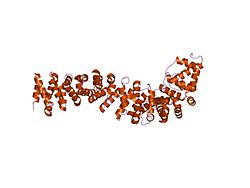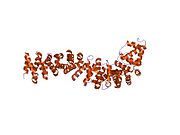Beta-catenin-interacting protein 1 is a protein that is encoded in humans by the CTNNBIP1 gene.
Function
The protein encoded by this gene binds CTNNB1 and prevents interaction between CTNNB1 and TCF (T-cell transcription factor) family members. The encoded protein is a negative regulator of the Wnt signaling pathway.
References
- ^ GRCh38: Ensembl release 89: ENSG00000178585 – Ensembl, May 2017
- ^ GRCm38: Ensembl release 89: ENSMUSG00000028988 – Ensembl, May 2017
- "Human PubMed Reference:". National Center for Biotechnology Information, U.S. National Library of Medicine.
- "Mouse PubMed Reference:". National Center for Biotechnology Information, U.S. National Library of Medicine.
- ^ "Entrez Gene: catenin".
- Tago K, Nakamura T, Nishita M, Hyodo J, Nagai S, Murata Y, Adachi S, Ohwada S, Morishita Y, Shibuya H, Akiyama T (July 2000). "Inhibition of Wnt signaling by ICAT, a novel beta-catenin-interacting protein". Genes Dev. 14 (14): 1741–9. doi:10.1101/gad.14.14.1741. PMC 316784. PMID 10898789.
Further reading
- Yochum GS, Cleland R, Goodman RH (2008). "A genome-wide screen for beta-catenin binding sites identifies a downstream enhancer element that controls c-Myc gene expression". Mol. Cell. Biol. 28 (24): 7368–79. doi:10.1128/MCB.00744-08. PMC 2593444. PMID 18852287.
- Sharma M, Henderson BR (2007). "IQ-domain GTPase-activating protein 1 regulates beta-catenin at membrane ruffles and its role in macropinocytosis of N-cadherin and adenomatous polyposis coli". J. Biol. Chem. 282 (11): 8545–56. doi:10.1074/jbc.M610272200. PMID 17255093.
- Takeda K, Kinoshita I, Shimizu Y, et al. (2008). "Clinicopathological significance of expression of p-c-Jun, TCF4 and beta-Catenin in colorectal tumors". BMC Cancer. 8: 328. doi:10.1186/1471-2407-8-328. PMC 2585585. PMID 18992165.
- Wang W, Zhang X, Deng K, et al. (2009). "ICAT as a potential enhancer of monocytic differentiation: implications from the comparative proteome analysis of the HL60 cell line stimulated by all-trans retinoic acid and NSC67657". Cell Biochem. Funct. 27 (6): 329–37. doi:10.1002/cbf.1576. PMID 19569129. S2CID 36742591.
- Wang WJ, Tang W, Qiu ZY (2009). "Comparative proteomics analysis on differentiation of human promyelocytic leukemia HL-60 cells into granulocyte and monocyte lineages". AI Zheng. 28 (2): 117–21. PMID 19550115.
- Reichel O, Mayr D, Durst F, Berghaus A (2008). "E-cadherin but not beta-catenin expression is decreased in laryngeal biopsies from patients with laryngopharyngeal reflux". Eur Arch Otorhinolaryngol. 265 (8): 937–42. doi:10.1007/s00405-007-0568-6. PMID 18183411. S2CID 9080577.
- Bazas VM, Lukyanova NY, Demash DV, et al. (2008). "Relation between cell-to-cell adhesion and angiogenesis and clinico-morphological prognostic factors in patients with gastric cancer". Exp. Oncol. 30 (3): 235–9. PMID 18806748.
- Kohler EM, Chandra SH, Behrens J, Schneikert J (2009). "Beta-catenin degradation mediated by the CID domain of APC provides a model for the selection of APC mutations in colorectal, desmoid and duodenal tumours". Hum. Mol. Genet. 18 (2): 213–26. doi:10.1093/hmg/ddn338. PMID 18854359.
- Seo E, Jho EH (2007). "Axin-independent phosphorylation of APC controls beta-catenin signaling via cytoplasmic retention of beta-catenin". Biochem. Biophys. Res. Commun. 357 (1): 81–6. doi:10.1016/j.bbrc.2007.03.117. PMID 17418091.
- Ladeiro Y, Couchy G, Balabaud C, et al. (2008). "MicroRNA profiling in hepatocellular tumors is associated with clinical features and oncogene/tumor suppressor gene mutations" (PDF). Hepatology. 47 (6): 1955–63. doi:10.1002/hep.22256. PMID 18433021. S2CID 15190293.
- Zhang H, Xue Y (2008). "Wnt pathway is involved in advanced gastric carcinoma". Hepatogastroenterology. 55 (84): 1126–30. PMID 18705344.
- Wang HX, Tekpetey FR, Kidder GM (2009). "Identification of WNT/beta-CATENIN signaling pathway components in human cumulus cells". Mol. Hum. Reprod. 15 (1): 11–7. doi:10.1093/molehr/gan070. PMID 19038973.
- Matono H, Oda Y, Nakamori M, et al. (2008). "Correlation between beta-catenin widespread nuclear expression and matrix metalloproteinase-7 overexpression in sporadic desmoid tumors". Hum. Pathol. 39 (12): 1802–8. doi:10.1016/j.humpath.2008.05.005. PMID 18715618.
- Wang L, O'Leary H, Fortney J, Gibson LF (2007). "Ph+/VE-cadherin+ identifies a stem cell like population of acute lymphoblastic leukemia sustained by bone marrow niche cells". Blood. 110 (9): 3334–44. doi:10.1182/blood-2007-01-068122. PMC 2200915. PMID 17638851.
- von Koch CS, Gulati M, Aldape K, Berger MS (2002). "Familial medulloblastoma: case report of one family and review of the literature". Neurosurgery. 51 (1): 227–33, discussion 233. doi:10.1097/00006123-200207000-00035. PMID 12182422. S2CID 21293611.
- Wang L, Li H, Zhang Y, et al. (2009). "HINT1 inhibits beta-catenin/TCF4, USF2 and NFkappaB activity in human hepatoma cells". Int. J. Cancer. 124 (7): 1526–34. doi:10.1002/ijc.24072. PMC 2667231. PMID 19089909.
- Chen Y, Bodles AM (2007). "Amyloid precursor protein modulates beta-catenin degradation". Journal of Neuroinflammation. 4: 29. doi:10.1186/1742-2094-4-29. PMC 2231348. PMID 18070361.
- Kastritis E, Murray S, Kyriakou F, et al. (2009). "Somatic mutations of adenomatous polyposis coli gene and nuclear b-catenin accumulation have prognostic significance in invasive urothelial carcinomas: evidence for Wnt pathway implication". Int. J. Cancer. 124 (1): 103–8. doi:10.1002/ijc.23917. PMID 18844223.
- Turbiner J, Moreno-Bueno G, Dahiya S, et al. (2008). "Clinicopathological and molecular analysis of endometrial carcinoma associated with tamoxifen". Mod. Pathol. 21 (8): 925–36. doi:10.1038/modpathol.2008.49. PMID 18500270.
- Ewing RM, Chu P, Elisma F, et al. (2007). "Large-scale mapping of human protein-protein interactions by mass spectrometry". Mol. Syst. Biol. 3 (1): 89. doi:10.1038/msb4100134. PMC 1847948. PMID 17353931.
External links
- CTNNBIP1+protein,+human at the U.S. National Library of Medicine Medical Subject Headings (MeSH)
- Human CTNNBIP1 genome location and CTNNBIP1 gene details page in the UCSC Genome Browser.
| PDB gallery | |
|---|---|
This article incorporates text from the United States National Library of Medicine, which is in the public domain.
This article on a gene on human chromosome 1 is a stub. You can help Misplaced Pages by expanding it. |







